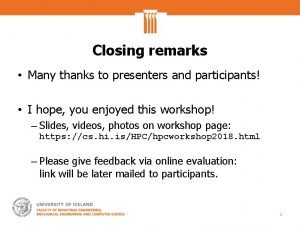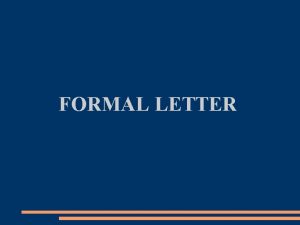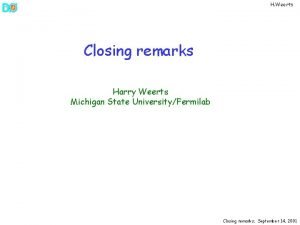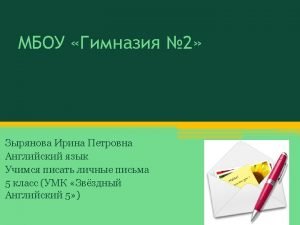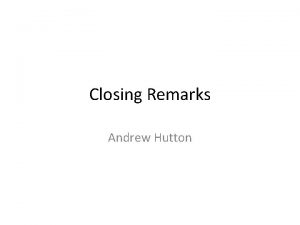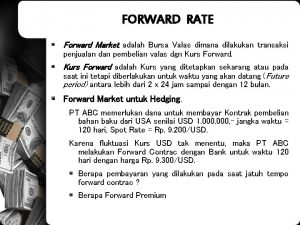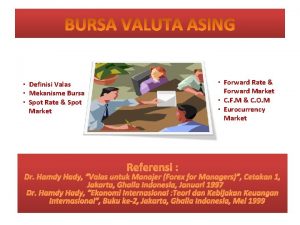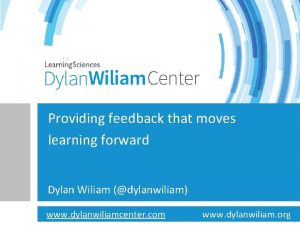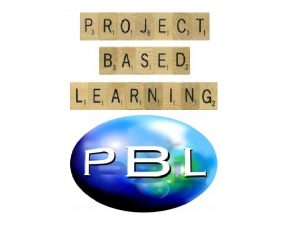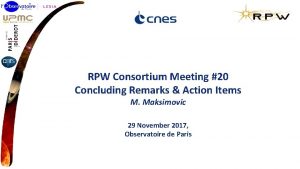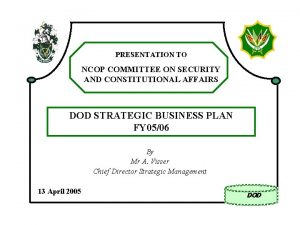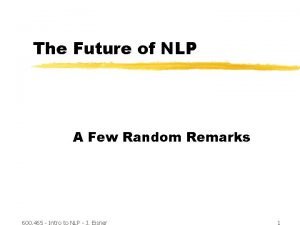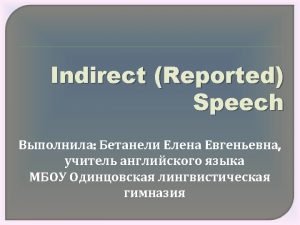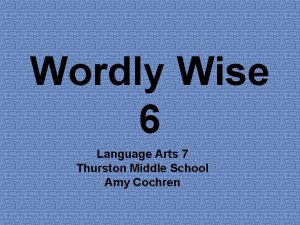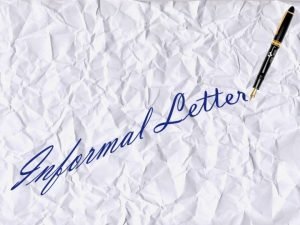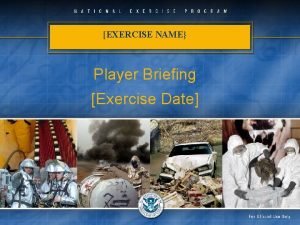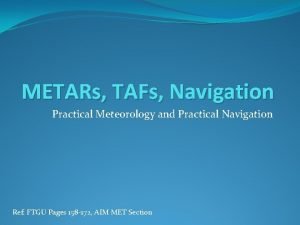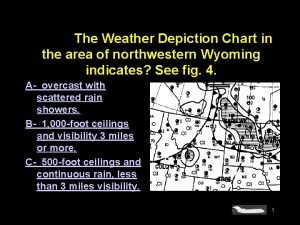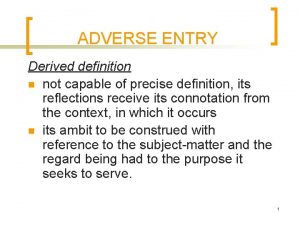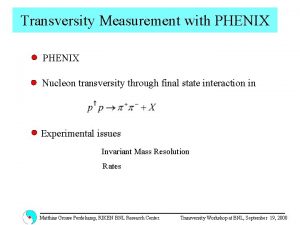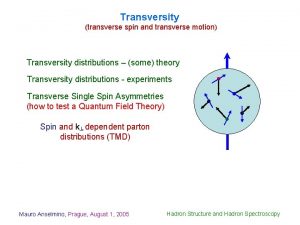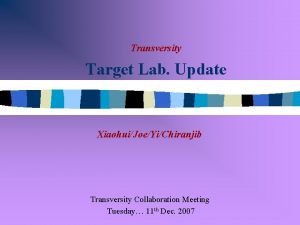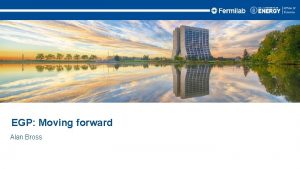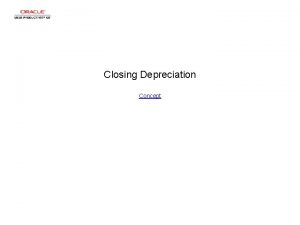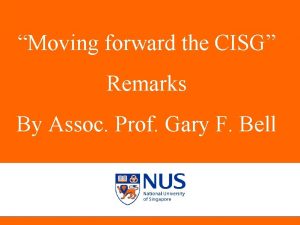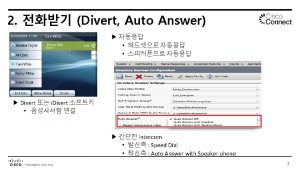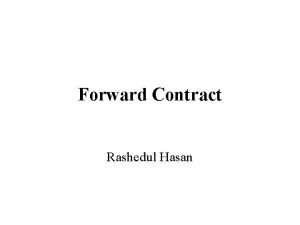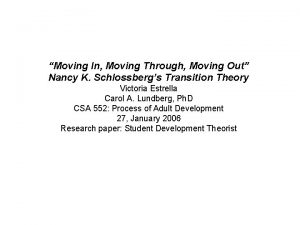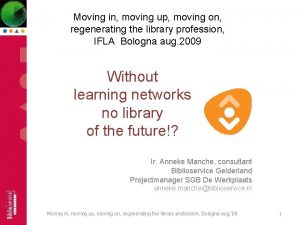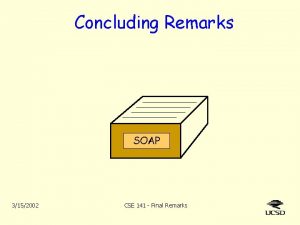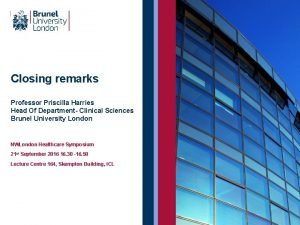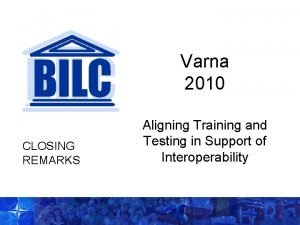Transversity 2014 Closing Remarks Moving Forward in the



































































- Slides: 67

Transversity 2014 Closing Remarks: Moving Forward in the Era of Quantitative QCD Christine A. Aidala University of Michigan Chia, Italy June 13, 2014

QCD: How far have we come? “You can’t anticipate all the things nature will do with that Lagrangian. ” – L. Bland • Three-decade period after initial birth of QCD dedicated to “discovery and development” Symbolic closure: Nobel prize 2004 - Gross, Politzer, Wilczek for asymptotic freedom Now early years of second phase: quantitative QCD! C. Aidala, Transversity 2014, June 13, 2014 2

Advancing into the era of quantitative QCD: Theory has been forging ahead! • In perturbative QCD, since 1990 s starting to consider detailed internal QCD dynamics that parts with traditional parton model ways of looking at hadrons—and perform phenomenological calculations using these new ideas/tools! E. g. : – – Various resummation techniques Non-linear evolution at small momentum fractions Non-collinearity of partons with parent hadron Spatial distributions of partons in hadrons • Non-perturbative methods: – Lattice QCD less and less limited by computing resources—since 2010 starting to perform calculations at the physical pion mass (after 36 years!). Plus recent new ideas on how to calculate previously intractable quantities. – Ad. S/CFT “gauge-string duality” an exciting recent development as first fundamentally new handle to try to tackle QCD in decades! C. Aidala, Transversity 2014, June 13, 2014 3

Effective field theories • QCD exhibits different behavior at different scales —effective field theories are useful approximations within these different regimes – Color Glass Condensate – high energies, high densities – Soft-Collinear Effective Theory – new insights into performing complicated perturbative calculations very quickly – Heavy Quark Effective Theory, Non-Relativistic QCD, . . . – Many effective theories for nonperturbative QCD – chiral symmetry breaking, . . . C. Aidala, Transversity 2014, June 13, 2014 4

Example: Threshold resummation to extend p. QCD to lower energies For observables with two different scales, sum logs of their ratio to all orders pp p 0 p 0 X M (Ge. V) Almeida, Sterman, Vogelsang PRD 80, 074016 (2009) C. Aidala, Transversity 2014, June 13, 2014 5

Example: Phenomenological applications of a non-linear gluon saturation regime at low x Phys. Rev. D 80, 034031 (2009) Fits to proton structure function data at low parton momentum fraction x. Basic framework for non-linear QCD, in which gluon densities are so high that there’s a nonnegligible probability for two gluons to combine, developed ~1997 -2001. But had to wait until “running coupling BK evolution” figured out in 2007 to compare directly to data! C. Aidala, Transversity 2014, June 13, 2014 6

Example: Dropping the simplifying assumption of collinearity Worm gear Collinear Transversity Sivers Polarizing FF Boer-Mulders Pretzelosity Worm gear Collins Many describe spin-momentum correlations: S • (p 1×p 2) C. Aidala, Transversity 2014, June 13, 2014 7

Example: Exploring spatial distributions Guidal, Moutarde, Vanderhaeghen, Rept. Prog. Phys. 76 (2013) 066202 CLAS HERMES Related talks by N. d’Hose, P. Kroll, G. Goldstein, A. Mukherjee, S. Pisano, A. Kim, A. Movsisyan, O. Eyser Sea quark polarized sea quark XB =0. 001 Mueller, 2011 Slide from N. d’Hose (backups) C. Aidala, Transversity 2014, June 13, 2014 8

Example: Progress in lattice Slide from J. -C. Peng T. Hatsuda, PANIC 2011 PACS-CS: PRD 81, 074503 (2010) BMW: PLB 701, 265 (2011) C. Aidala, Transversity 2014, June 13, 2014 9

Example: Effective field theories Soft Collinear Effective Theory – p. T distribution for gg Higgs vs. p. T ar. Xiv: 1108. 3609 “Modern-day ‘testing’ of (perturbative) QCD is as Related talks bythe I. Scimemi, M. much about pushing boundaries of its Echevarria, A. Idilbi applicability as about the verification that QCD is the correct theory of hadronic physics. ” – G. Salam, hep-ph/0207147 (DIS 2002 proceedings) C. Aidala, Transversity 2014, June 13, 2014 10

Experimental advances • More sophisticated observables – E. g. angular distributions, spin dependence, multiparticle final states, . . . – Often sensitive to parton dynamics • Multidifferential measurements – E. g. simultaneously in x, Q 2, p. T Demand more of theoretical calculations! C. Aidala, Transversity 2014, June 13, 2014 11

Multidifferential data: SIDIS JLab Hall B Talks by M. Contalbrigo, A. Bressan, G. Karyan, N. Makke, B. Parsamyan, C. Braun, C. van Hulse, A. Puckett, S. Pisano; O. Eyser O. Gonzalez Hernandez SIDIS phenomenology talk: 1341 points HERMES, 5385 points COMPASS! C. Aidala, Transversity 2014, June 13, 2014 12

Multidifferential data: E 866 D-Y From J. Webb thesis. 1 of 26 pages(!) of similar tables. D-Y cross section for p+p, p+d multidifferential in M, x. F, p. T C. Aidala, Transversity 2014, June 13, 2014 13

Multidifferential data: e+e. BABAR Talks by I. Garzia, M. Grosse Perdekamp, F. Giordano BELLE (Okay, the BELLE hadron multiplicities aren’t multidifferential (yet), but they’re still quite impressive!) C. Aidala, Transversity 2014, June 13, 2014 14

Understanding theory doesn’t mean knowing how to do phenomenology • Current example: TMD evolution. . . – Talks by S. Melis, J. Collins, W. Vogelsang, L. Gamberg, I. Scimemi, M. Echevarria, A. Prokudin, A. Signori, O. Gonzalez Hernandez, O. Teryaev (9 presentations—only 1 at Transversity 2011!) • Lots of (sometimes animated!) debates – Means we’ve now advanced to the point of worrying about things we didn’t even consider several years ago Progress! C. Aidala, Transversity 2014, June 13, 2014 15

Gauge links have physical consequences Collins, 1993 From M. Anselmino Talks on polarized D -Y by L. Bland, A. Vossen, J. -C. Peng, M. Chiosso, + SIDIS Sivers talks. . . C. Aidala, Transversity 2014, June 13, 2014 Talks related to Wilson lines by M. Buffing, F. van der Veken 16

Physical consequences of a gauge-invariant quantum theory: Aharonov-Bohm (1959) Wikipedia: “The Aharonov–Bohm effect is important conceptually because it bears on three issues apparent in the recasting of (Maxwell's) classical electromagnetic theory as a gauge theory, which before the advent of quantum mechanics could be argued to be a mathematical reformulation with no physical consequences. The Aharonov–Bohm thought experiments and their experimental realization imply that the issues were not just philosophical. The three issues are: • whether potentials are "physical" or just a convenient tool for calculating force fields; • whether action principles are fundamental; • the principle of locality. ” C. Aidala, Transversity 2014, June 13, 2014 17

Physical consequences of a gauge-invariant quantum theory: Aharonov-Bohm (1959) Physics Today, September 2009 : The Aharonov–Bohm effects: Variations on a subtle theme, by Herman Batelaan and Akira Tonomura. “Aharonov stresses that the arguments that led to the prediction of the various electromagnetic AB effects apply equally well to any other gauge-invariant quantum theory. In the standard model of particle physics, the strong and weak nuclear interactions are also described by gauge-invariant theories. So one may expect that particle-physics experimenters will be looking for new AB effects in new domains. ” C. Aidala, Transversity 2014, June 13, 2014 18

Physical consequences of a gauge-invariant quantum theory: Aharonov-Bohm effect in QCD!! Deep-inelastic lepton-nucleon scattering: Attractive final-state interactions Quark-antiquark annihilation to leptons: Repulsive initial-state interactions Simplicity of these two processes: Abelian vs. non-Abelian nature of the gauge group doesn’t play a major qualitative role. BUT: In QCD expect additional, new effects due to specific non-Abelian nature of See thee. g. Pijlman, hep-ph/0604226 As a result: gauge group or Sivers, ar. Xiv: 1109. 2521 C. Aidala, Transversity 2014, June 13, 2014 19

QCD Aharonov-Bohm effect: Color entanglement • 2010: Rogers and Mulders predict color entanglement in processes involving p+p production of We if need to transverse refine how we communicate this hadrons quark PRD 81: 094006 (2010) fundamental physics to other momentum taken into account communities… Every Ph. D. physicist has • Quarks become correlated across studied the Aharonov-Bohm effect! the two protons Color flow can’t be described as • Consequence of QCD specifically flow in the two gluons separately. Requires simultaneous presence as a non-Abelian gauge theory! of both. C. Aidala, Transversity 2014, June 13, 2014 20

Some thoughts on future directions. . . 4 areas I expect to come into increasing focus: • • Sea quarks Multiparton correlations Partonic structure of nuclei Hadronization C. Aidala, Transversity 2014, June 13, 2014 21

Diving into the sea • There’s a lot going on in there. . . • Sometimes we focus our attention on the sea, often we neglect it C. Aidala, Transversity 2014, June 13, 2014 22

Light quark sea: Not simply gluon splitting E 866 Mean p. T rises with x of sea quark? E 866: PRD 64, 052002 (2001) Talk by J. -C. Peng Projections for E 906: Results soon! C. Aidala, Transversity 2014, June 13, 2014 23

Drell-Yan: Transverse momentum of valence vs. sea quarks Plot from CAA, Field, Gamberg, Rogers, PRD 89, 094002 (2014) (Normalization scaled) p+W: (Valence) quark from p, (sea) antiquark from W pbar+W: (Valence) quark from W, (valence) antiquark from pbar Different slope, although not (quite) apples-toapples kinematics. Data: AIP Conf. Proc. 45, 93 (1978) PRD 38, 1377 (1988) C. Aidala, Transversity 2014, June 13, 2014 (Valence x sea) spectrum harder Larger mean k. T for sea than valence quarks? 24

Boer-Mulders for sea quarks small? ? Transversity for sea quarks large? ? E 866, PRL 99, 082301 (2007); PRL 102, 182001 (2009) From J. -C. Peng E 866 Also P. Zavada - k. T of sea quarks in covariant approach Need more data. . . C. Aidala, Transversity 2014, June 13, 2014 25

p 200 Ge. V p, K, p at 200 and 62. 4 Ge. V p 62. 4 Ge. V Note different scales K 200 Ge. V p 200 Ge. V K- asymmetries underpredicted K Pions suggest valence quark effect. 62. 4 Ge. V Kaons and (anti)protons don’t! Large antiproton asymmetry? ? Unfortunately no 62. 4 Ge. V measurement C. Aidala, Transversity 2014, June 13, 2014 p PRL 101, 042001 (2008) 62. 4 Ge. V 26

p+p h AN larger than p 0? ? Same? In addition to sea quarks, need to explore dynamics of gluons in more depth—talks by M. Echevarria, M. Schlegel, A. Szabelski, Y. Koike ar. Xiv: 1406. 3541 Related talks by L. Bland, D. Kleinjan, A. Vossen, A. Ogawa, Y. Koike, D. Pitonyak, C. Pisano C. Aidala, Transversity 2014, June 13, 2014 27

Partonic structure of nuclei Nuclei: Not simple superpositions of nucleons! Rich and intriguing differences compared to free nucleons, which vary with the linear momentum fraction probed (and likely transverse momentum, impact parameter, . . . ). Related talks by E. Pace, A. Puckett Understanding the nucleon in terms of the quark and gluon d. o. f. of QCD does NOT allow us to understand nuclei in terms of the C. colored constituents inside them! Aidala, DNP, October 27, 2011 28

Upcoming opportunities at JLab • Tritium target approved - talk by A. Puckett – Can perform same measurements on mirror nuclei 3 H and 3 He • JLab Hall A will take DIS data on tritium target in 2015 – Same experiment will measure DIS on 3 He – Explore nuclear effects, isospin symmetry assumptions, neutron structure, . . . • Other tritium experiments to follow • We need many similar apples-to-apples comparison experiments as we move ahead—keep ~everything the same except for one variable C. Aidala, Transversity 2014, June 13, 2014 29

Multiparton correlations • Similar effects across energies Continuum between nonperturbative/non-partonic and perturbative/partonic descriptions of this non-perturbative structure? ? • Extend our ideas about (single-parton) pdfs to correlation functions that can’t be associated with a single parton. . . • Talk by D. Sivers C. Aidala, Transversity 2014, June 13, 2014 30

Twist-3 multiparton correlations to interpret inclusive AN data from RHIC Talks by Y. Koike, D. Pitonyak Making progress! C. Aidala, Transversity 2014, June 13, 2014 31

Inclusive hadron AN in e+p Talk by A. Prokudin C. Aidala, Transversity 2014, June 13, 2014 32

Hadronization • Not as far along as nucleon structure—less of a focus in earlier years • Recent advances via – TMD FFs – Collinear twist-3 functions to describe hadronization – Dihadron (interference) FF – Hadronization from nuclei Related talks by M. Radici, A. Kotzinian, I. Garzia, M. Grosse Perdekamp, F. Giordano, M. Contalbrigo, Y. Guan, O. Eyser, A. Vossen, + other p+p talks and all SIDIS talks. . . C. Aidala, Transversity 2014, June 13, 2014 33

From talks by C. van Hulse, A. Vossen, C. Braun, F. Giordano Now ar. Xiv: 1406. 3236! C. Aidala, Transversity 2014, June 13, 2014 34

Identified hadron production: Ratios p. QCD uncertainties only from (FF) scale uncertainty • Measured p-/p+ ratio significantly below NLO calculation in lower range of p. T – Data: Normalization uncertainties cancel completely – Calculation: Scale uncertainty greatly reduced Similar issue for eta/pi 0 ratio. . . PRD 83, 032001 (2011) • PHENIX ratio consistent with STAR points, which lie many sigma below NLO calculation out to ~10 Ge. V • More powerful to fit ratios directly in the future where available C. Aidala, Transversity 2014, June 13, 2014 35

Eventually even more global fits? • Perform FF parameterizations for even more particles simultaneously? – Will constrain relative normalizations well • Ultimate goal: Measure jet and all particles within it! • Fit pdfs and FFs simultaneously. . . PRD 83, 052004 (2011) C. Aidala, Transversity 2014, June 13, 2014 36

Mechanisms of hadronization other than “fragmentation”: Baryon enhancement in d+Au and Au+Au • Precision d+Au data for identified charged hadrons in bins of centrality • New hadron production mechanism enabled by presence of additional partons/nucleons – Parton recombination? • Strong centrality dependence despite small range of # participants • Well-known centralitydependent baryon enhancement in Au+Au – Previously explained by recombination of thermalized partons PRC 88, 024906 (2013) C. Aidala, Transversity 2014, June 13, 2014 37

Comparing central d+Au with peripheral Au+Au Both shape and magnitude identical! Suggests common mechanism(s) for baryon production in the two systems—partons nearby in phase space bind? Don’t need thermalized medium PRC 88, 024906 (2013) C. Aidala, Transversity 2014, June 13, 2014 38

Bound states of hadronic bound states: Creating nuclei! STAR Nature 473, 353 (2011) C. Aidala, Transversity 2014, June 13, 2014 39

A cyclical process “Starting out, you take the simplest ansatz. ” – P. Kroll “We must not give up our intuition. ” – M. Anselmino Proliferation of observations and ideas Synthesis C. Aidala, Transversity 2014, June 13, 2014 40

Increasing connections among (historically disparate) areas of QCD As we advance, we’re building more connections among the various areas of QCD • • TMD and HEP theory communities – SCET, QT resummation Jet substructure in HEP and TMD, higher-twist, or dihadron FFs TMDs at the LHC – M. Schlegel, J. P. Lansberg talks Multiparton Interactions (MPI) in HEP community and multiparton correlations • Nucleon structure, HEP, and heavy ion low-x communities – gluon saturation • Heavy ion and nucleon structure communities - Nuclear pdfs, mainly “vanilla” collinear so far, but starting to consider TMD – E. Pace talk • Heavy ion and neutron star communities – dense, hot vs. dense, cold corners of QCD phase diagram C. Aidala, Transversity 2014, June 13, 2014 41

Increasing connections among (historically disparate) areas of QCD • Heavy ion and hadronization - “fragmentation” vs. nearby partons in phase space; parton energy loss in hot or cold nuclear matter (M. Contalbrigo talk) • Heavy ion (quark-gluon plasma) physics and low-energy nuclear reactions; cosmology – “Little Bang Nucleosynthesis” • Diffractive physics in heavy ion collisions and GPDs; Impact-parameterdependent nuclear distributions and collision geometry in heavy ion physics; GPDs and proton radius puzzle via form factors • OAM (E. Leader and M. Burkardt talks) and GPDs, TMDs (A. Mukherjee talk) • Hadron spectroscopy and OAM – D. Sivers talk • Hadron spectroscopy and hadronization/FFs—B factories as common facilities • Hadronic vs. partonic dof in JLab program and moving beyond singleparton functions in hadrons C. Aidala, Transversity 2014, June 13, 2014 42

We should make every effort to strengthen these links • E. g. stronger links to mainstream HEP experimental community – There’s lots of QCD physics to be done in p+p collisions at the LHC! – Share more Monte Carlo tools? (G. Schnell, H. Avakian talks) – 125 Ge. V Higgs: e+e- Higgs factory would be great to study FFs at a complementary scale to current B factories! “Unpolarized reactions are the basic tool linking many different fields of investigation. ” – M. Contalbrigo C. Aidala, Transversity 2014, June 13, 2014 43

Final remarks • Early years of quantitative basic research in QCD • Proton has key role to play as lightest stable QCD bound state (and component of everyday matter!) • Electron-Ion Collider: Facility to bring the era of quantitative QCD to maturity. . . BUT— • Measurements in complementary systems important! • More connections starting to be developed among various QCD subfields • Taking small, initial steps along the path toward “grand unification” of QCD across different scales, from partons to neutron stars. . . C. Aidala, Transversity 2014, June 13, 2014 44

C. Aidala, Transversity 2014, June 13, 2014 45

Thanks for making this such a nice community. . . C. Aidala, Transversity 2014, June 13, 2014 46

Extra C. Aidala, Transversity 2014, June 13, 2014 47

Mapping out the proton What does the proton look like in terms of the quarks and gluons inside it? Theoretical and experimental concepts to describe and • Position access position only born in mid-1990 s. Pioneering Vast majority of past four decades focused on measurements over past decade. • Momentum 1 -dimensional momentum structure! Since 1990 s Polarized protons first studied in 1980 s. How angular starting to consider transverse components. . . • Spin momentum of quarks and gluons add up still not well Early measurements understood! of flavor distributions in valence • Flavor region. Flavor structure at lower momentum fractions Accounted for still by theorists beginning of QCD, yielding from surprises! • Color but more detailed, potentially observable effects of color have come to forefront in last couple years. . . C. Aidala, Transversity 2014, June 13, 2014 48

EIC • A facility to bring this new era of quantitative QCD to maturity! • How can QCD matter be described in terms of the quark and gluon d. o. f. in the field theory? • How does a colored quark or gluon become a colorless object? • Study in detail – “Simple” QCD bound states: Nucleons – Collections of QCD bound states: Nuclei – Hadronization C. Aidala, Transversity 2014, June 13, 2014 49

Midrapidity charge-separated hadrons in 62. 4 Ge. V p+p: Reining in scale uncertainties with NLL resummation C. Aidala, Transversity 2014, June 13, 2014 50

Forward charged p and K production at 62. 4 Ge. V C. Aidala, Transversity 2014, June 13, 2014 51

Scale uncertainty remains large for singleparticle cross sections even for √s =500 Ge. V and p. T up to 30 Ge. V • “Good” agreement with NLO, but still only within ~20 -50% • Measured p-/p+ ratio at 200 Ge. V within ~15% of NLO calculation, but less “good” because of greatly reduced scale uncertainties – Evidently other uncertainties relevant • What are the most appropriate uncertainties to use in each case? C. Aidala, Transversity 2014, June 13, 2014 52

NNPDF dbar/ubar C. Aidala, Transversity 2014, June 13, 2014 53

Fermilab E 1039 C. Aidala, Transversity 2014, June 13, 2014 54

Eta vs. kaon AN? ar. Xiv: 1406. 3541 PRL 101, 042001 (2008) PHENIX Eta vs. kaons—kaons higher. . . ? C. Aidala, Transversity 2014, June 13, 2014 Kaons higher, including K-, although not apples-toapples. 55

Hadronization: A lot to learn, from a variety of collision systems What are the ways in which partons can turn into hadrons? • Spin-momentum correlations in hadronization? – Correlations now measured definitively in e+e-! (BELLE, BABAR) • Gluons vs. quarks? – Gluon vs. quark jets a hot topic in the LHC p+p program right now In my opinion, hadronization has been a largely – Go back to clean e+e- with new jet analysis techniques in hand? area the pastvs. decades of QCD—lots • Inneglected “vacuum” vs. coldover nuclear matter hot + dense matter? • of – progress Use path lengths through nuclei to benchmark hadronization times e+A to look forward to in upcoming years, with Hadronization via “fragmentation” (what does that really mean? ), “freeze+ e+A, p+p, and A+A out, ” “recombination, ”. . . ? all playing a role along with e e ! – Soft hadron production from thermalized quark-gluon plasma—different mechanism than hadronization from hard-scattered q or g? • Light atomic nuclei and antinuclei also produced in heavy ion collisions at RHIC! – How are such “compound” QCD systems formed from partons? Cosmological implications? ? • … C. Aidala, Transversity 2014, June 13, 2014 56

Comparing central d+Au with peripheral Au+Au • Direct ratio of spectra is flat above 2. 5 Ge. V and species independent PRC 88, 024906 (2013) No scaling applied – Baryon enhancement is quantitatively the same – Ratio significantly less than unity— suggests energy loss for all species in peripheral Au+Au C. Aidala, Transversity 2014, June 13, 2014 57

Enhancement of strange meson production in central Au+Au • K/p ratio higher in more central Au+Au than p+p, increases with centrality • K/p ratio in d+Au same as p+p for all centralities C. Aidala, Transversity 2014, June 13, 2014 58

Strange meson production in Au+Au • In Au+Au, kaon and pion most separated in central events • Phi seems to stay between kaon and proton • In d+Au, charged pions and kaons consistent with each other, and phi exhibits minimal modification • Suggests additional strange meson production mechanism in central Au+Au compared to d+Au or p+p C. Aidala, Transversity 2014, June 13, 2014 59

• Insight from New Measurements New information on proton structure – GE(Q 2) ≠ GM(Q 2) different charge, magnetization distributions – Connection to GPDs: spin-space-momentum correlations Model-dependent extraction of charge, magnetization distribution of proton: J. Kelly, Phys. Rev. C 66, 065203 (2002) A. Belitsky, X. Ji, F. Yuan, PRD 69: 074014 (2004) G. Miller, PRC 68: 022201 (2003) x=0. 1 x=0. 4 x=0. 7 1 fm Slide courtesy J. Arrington C. Aidala, Transversity 2014, June 13, 2014 60

Eta mesons in 200 Ge. V p+p • Cross section data used in FF fit • NLO calculation for h/p 0 ratio ~15% too low (no uncertainties shown) • In this particular case, PHENIX eta data and (earlier but consistent) p 0 data were used in the respective FF fits, but in p 0 fit, PHENIX data normalization scaled within uncertainty in one direction, and in eta fit, scaled in other direction • Fitting ratio directly would automatically take into account the 100% correlated normalization uncertainties PRD 83, 032001 (2011) C. Aidala, Transversity 2014, June 13, 2014 61

ALICE h/p 0 ratio, p+p at 7 Te. V • Same p. T range as PHENIX data • Calculated ratio again below data • Scale uncertainty on NLO calculation shown PLB 717, 152 (2012) C. Aidala, Transversity 2014, June 13, 2014 62

Density dependence of EMC effect? J. Seely, et al. , PRL 103, 202301 (2009) N. Fomin, et al. , PRL 108 (2012) 092052 Credit: P. Mueller C. Aidala, Transversity 2014, June 13, 2014 63

Connection between short-range correlations and EMC effect: Importance of two-body effects? ? 5 -10% suppression in all nucleons? 25 -50% change in 20% of nucleons (high-momentum)? J. Seely, et al. , PRL 103, 202301 (2009) N. Fomin, et al. , PRL 108, 092052 (2012) JA, A. Daniel, D. Day, N. Fomin, D. Gaskell, P. Solvignon, PRC 86 (2012) 065204 O. Hen, et al. , PRC 85, 047301 (2012) L. Weinstein, et al. , PRL 106, 052301 (2011) C. Aidala, Transversity 2014, June 13, 2014 64

p+p cross sections: Charged pions, 200 Ge. V 10% normalization uncertainty not shown • Charge-separated pion cross sections 5 < p. T < 14 Ge. V • Consistent with NLO p. QCD calculations using DSS FFs, within (large) scale uncertainty • Data themselves have 10% normalization uncertainty • Use as input in future fits— how best to incorporate? C. Aidala, Transversity 2014, June 13, 2014 65

C. Aidala, Transversity 2014, June 13, 2014 66

Mechanisms of hadronization other than “fragmentation”: Baryon enhancement in d+Au and Au+Au • Precision d+Au data for identified charged hadrons in bins of centrality • New hadron production mechanism enabled by presence of additional partons/ nucleons – Parton recombination? • Strong centrality dependence despite small range of Npart and Ncoll values in d+Au • Well-known centralitydependent baryon enhancement in Au+Au PRC 88, 024906 (2013) C. Aidala, Transversity 2014, June 13, 2014 67
 Closing remarks sample tagalog
Closing remarks sample tagalog Closing remarks for thesis defense
Closing remarks for thesis defense Closing remarks for webinar
Closing remarks for webinar Rules for writing a formal letter
Rules for writing a formal letter Sample of closing remarks
Sample of closing remarks How to end informal letter
How to end informal letter Birthday closing remarks
Birthday closing remarks Closing remarks examples
Closing remarks examples Forward rate dan forward market
Forward rate dan forward market Forward rate dan forward market
Forward rate dan forward market Moving dartmouth forward
Moving dartmouth forward Dylan wiliam feedback on learning
Dylan wiliam feedback on learning Keep moving forward meet the robinsons
Keep moving forward meet the robinsons Rpw comment
Rpw comment Remarks in action plan
Remarks in action plan Random remarks
Random remarks Sample of remarks
Sample of remarks How did postema feel about sexist remarks from spectators
How did postema feel about sexist remarks from spectators How to adress a letter
How to adress a letter Contoh remarks
Contoh remarks Report card remarks
Report card remarks Briefing exercise
Briefing exercise One of your classmates remarks that mary is all id
One of your classmates remarks that mary is all id Gfk metar
Gfk metar Natural indicators
Natural indicators Taf meteorology
Taf meteorology What is weather depiction chart?
What is weather depiction chart? Grading system in college philippines
Grading system in college philippines Irremedial
Irremedial Todays sabbath school lesson
Todays sabbath school lesson Lazy and eager learning
Lazy and eager learning Vẽ hình chiếu vuông góc của vật thể sau
Vẽ hình chiếu vuông góc của vật thể sau Công thức tiính động năng
Công thức tiính động năng Thế nào là mạng điện lắp đặt kiểu nổi
Thế nào là mạng điện lắp đặt kiểu nổi Tỉ lệ cơ thể trẻ em
Tỉ lệ cơ thể trẻ em Lời thề hippocrates
Lời thề hippocrates Vẽ hình chiếu đứng bằng cạnh của vật thể
Vẽ hình chiếu đứng bằng cạnh của vật thể Quá trình desamine hóa có thể tạo ra
Quá trình desamine hóa có thể tạo ra Kể tên các môn thể thao
Kể tên các môn thể thao Hình ảnh bộ gõ cơ thể búng tay
Hình ảnh bộ gõ cơ thể búng tay Khi nào hổ con có thể sống độc lập
Khi nào hổ con có thể sống độc lập điện thế nghỉ
điện thế nghỉ Dot
Dot Nguyên nhân của sự mỏi cơ sinh 8
Nguyên nhân của sự mỏi cơ sinh 8 Trời xanh đây là của chúng ta thể thơ
Trời xanh đây là của chúng ta thể thơ Phản ứng thế ankan
Phản ứng thế ankan Gấu đi như thế nào
Gấu đi như thế nào Thiếu nhi thế giới liên hoan
Thiếu nhi thế giới liên hoan Fecboak
Fecboak Một số thể thơ truyền thống
Một số thể thơ truyền thống Thế nào là hệ số cao nhất
Thế nào là hệ số cao nhất Slidetodoc
Slidetodoc Sơ đồ cơ thể người
Sơ đồ cơ thể người Các số nguyên tố là gì
Các số nguyên tố là gì đặc điểm cơ thể của người tối cổ
đặc điểm cơ thể của người tối cổ Mật thư tọa độ 5x5
Mật thư tọa độ 5x5 Các châu lục và đại dương trên thế giới
Các châu lục và đại dương trên thế giới Glasgow thang điểm
Glasgow thang điểm ưu thế lai là gì
ưu thế lai là gì Thẻ vin
Thẻ vin Tư thế ngồi viết
Tư thế ngồi viết Cái miệng nó xinh thế
Cái miệng nó xinh thế Các châu lục và đại dương trên thế giới
Các châu lục và đại dương trên thế giới Từ ngữ thể hiện lòng nhân hậu
Từ ngữ thể hiện lòng nhân hậu Bổ thể
Bổ thể Tư thế ngồi viết
Tư thế ngồi viết Thế nào là giọng cùng tên
Thế nào là giọng cùng tên Phép trừ bù
Phép trừ bù

